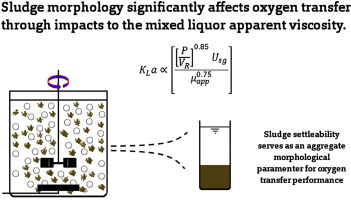当前位置:
X-MOL 学术
›
Water Res.
›
论文详情
Our official English website, www.x-mol.net, welcomes your
feedback! (Note: you will need to create a separate account there.)
Filamentous organisms degrade oxygen transfer efficiency by increasing mixed liquor apparent viscosity: Mechanistic understanding and experimental verification.
Water Research ( IF 11.4 ) Pub Date : 2020-02-07 , DOI: 10.1016/j.watres.2020.115570 Ken Campbell 1 , Jianmin Wang 1 , Glen T Daigger 2
Water Research ( IF 11.4 ) Pub Date : 2020-02-07 , DOI: 10.1016/j.watres.2020.115570 Ken Campbell 1 , Jianmin Wang 1 , Glen T Daigger 2
Affiliation

|
Recent findings have demonstrated that activated sludge morphology significantly impacts oxygen transfer efficiency (OTE) in the activated sludge process. In this study, we developed a mechanistic understanding of this impact. Mixed liquor samples collected from a domestic wastewater treatment plant (WWTP) were blended with a bulking activated sludge from a bench scale reactor (BSR) cultured on synthetic wastewater to manipulate various morphological parameters such as the settled sludge volume (SV), the sludge volume index (SVI), and the specific filament length (SFL). The filaments that were present in the blended sludges consisted largely of Type 0041 and Type 021N, which are commonly found in WWTPs that treat domestic wastewater. Variations in sludge morphology, as quantified by settled sludge volume after 30 min (SV30), SVI, and SFL, systematically affected the mixed liquor apparent viscosity (μapp), which consequently impacted OTE. An increase in the SFL from 9.61 × 106 μm g-1 to 6.88 × 107 μm g-1 resulted in a 41.4% increase in apparent viscosity and a 24.6% decrease in volumetric mass transfer coefficient (KLa). A new parameter, named the ultimate settleability (SVULT), was developed by curve fitting the SV versus time data and found to relate with μapp through an expanded form of the Einstein Equation for the viscosity. Therefore, SVULT is a corollary for the particle volume fraction that incorporates effects of both the sludge morphology and mass concentration on μapp. Theoretical derivation revealed that an increase in SVULT resulted in an increase in μapp, which reduced oxygen transfer by increasing the air bubble size and reducing refreshment of the liquid at the gas-liquid interface. The KLa was found to be inversely proportional to μapp0.75 through fitting the experimental data with the theoretical model. Using a variance-based global sensitivity analysis, three operating parameters that have the most impact on oxygen transfer were identified: the power input per unit volume, the superficial gas flowrate, and the μapp.
中文翻译:

丝状生物通过增加混合液的表观粘度降低了氧气的输送效率:机理的理解和实验验证。
最近的发现表明,活性污泥的形态显着影响了活性污泥工艺中的氧转移效率(OTE)。在这项研究中,我们对这种影响产生了机械的理解。从家用废水处理厂(WWTP)收集的混合液样品与台式反应器(BSR)的膨化活性污泥混合,在合成废水中培养,以处理各种形态参数,例如沉降污泥量(SV),污泥量指数(SVI)和特定的灯丝长度(SFL)。混合污泥中存在的长丝主要由0041型和021N型组成,通常在处理生活污水的污水处理厂中发现。通过30分钟(SV30),SVI和SFL后沉降的污泥量来量化的污泥形态变化,系统地影响混合液的表观粘度(μapp),从而影响OTE。SFL从9.61×106μmg-1增加到6.88×107μmg-1,导致表观粘度增加41.4%,体积传质系数(KLa)减少24.6%。通过对SV与时间数据进行曲线拟合,开发了一个名为极限沉降性(SVULT)的新参数,并通过爱因斯坦方程式的扩展形式发现了与μapp相关的粘度。因此,SVULT是结合了污泥形态和质量浓度对μapp的影响的颗粒体积分数的推论。理论推导显示,SVULT的增加导致μapp的增加,通过增加气泡大小并减少气液界面处的液体更新来减少氧气的转移。通过将实验数据与理论模型进行拟合,发现KLa与μapp0.75成反比。使用基于方差的全局灵敏度分析,确定了对氧气传输影响最大的三个运行参数:每单位体积的功率输入,表面气体流速和μapp。
更新日期:2020-02-07
中文翻译:

丝状生物通过增加混合液的表观粘度降低了氧气的输送效率:机理的理解和实验验证。
最近的发现表明,活性污泥的形态显着影响了活性污泥工艺中的氧转移效率(OTE)。在这项研究中,我们对这种影响产生了机械的理解。从家用废水处理厂(WWTP)收集的混合液样品与台式反应器(BSR)的膨化活性污泥混合,在合成废水中培养,以处理各种形态参数,例如沉降污泥量(SV),污泥量指数(SVI)和特定的灯丝长度(SFL)。混合污泥中存在的长丝主要由0041型和021N型组成,通常在处理生活污水的污水处理厂中发现。通过30分钟(SV30),SVI和SFL后沉降的污泥量来量化的污泥形态变化,系统地影响混合液的表观粘度(μapp),从而影响OTE。SFL从9.61×106μmg-1增加到6.88×107μmg-1,导致表观粘度增加41.4%,体积传质系数(KLa)减少24.6%。通过对SV与时间数据进行曲线拟合,开发了一个名为极限沉降性(SVULT)的新参数,并通过爱因斯坦方程式的扩展形式发现了与μapp相关的粘度。因此,SVULT是结合了污泥形态和质量浓度对μapp的影响的颗粒体积分数的推论。理论推导显示,SVULT的增加导致μapp的增加,通过增加气泡大小并减少气液界面处的液体更新来减少氧气的转移。通过将实验数据与理论模型进行拟合,发现KLa与μapp0.75成反比。使用基于方差的全局灵敏度分析,确定了对氧气传输影响最大的三个运行参数:每单位体积的功率输入,表面气体流速和μapp。











































 京公网安备 11010802027423号
京公网安备 11010802027423号